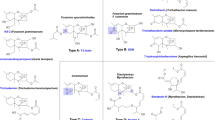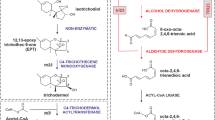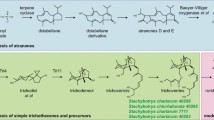Abstract
Macrocyclic trichothecenes are toxic sesquiterpenoids that are produced by certain fungi and plants. The unique structural features of macrocyclic trichothecenes result in increased toxicity relative to other trichothecene structural types. Here we report the sequences and relative locations of the MRTRI5, MRTRI6, and MRTRI4 genes in the biosynthetic pathway for macrocyclic trichothecenes in Myrothecium roridum. The deduced sequences of the products of MRTRI5 and MRTRI4 display overall identities of 75 and 63%, respectively, with the corresponding proteins in Fusarium sporotrichioides. Based on sequence comparisons, MRTRI5 encodes the enzyme trichodiene synthase, which has been shown to catalyze the first step in the trichothecene pathways of Fusarium and Trichothecium species. MRTRI6 encodes a transcription factor (392 amino acids) required for pathway gene expression, and the predicted MRTRI4 product (533 amino acids) is a cytochrome P450 monooxygenase responsible for the initial oxygenation step in the pathway. The sizes of the predicted products of MRTRI5 and MRTRI4 show good agreement with their apparent counterparts in the Fusarium pathway; however, the protein specified by MRTRI6 is almost twice the size of its putative homolog in F. sporotrichioides. Only the C-terminal 124 residues of MRTRI6, containing the proposed Cys2His2 zinc finger motifs, show significant similarity (65% identity) to the TRI6 sequence in F. sporotrichioides. MRTRI4 can successfully complement a TRI4 − mutant in F. sporotrichioides, although the resulting trichothecene profile differed from that observed in wild-type strains. Complemented mutants accumulated low levels of T-2 toxin, in addition to sambucinol, deoxysambucinol, and the pathway intermediates trichothecene and isotrichodiol. Mapping data indicate that the genes of the macrocyclic trichothecene pathway in M. roridum are clustered, but that their organization and orientation differ markedly from those of the trichothecene gene cluster found in F. sporotrichioides. These results show that the biosynthetic pathways for macrocyclic trichothecenes are closely related to other trichothecene pathways and that the evolution of gene clusters for the biosynthesis of natural products in fungi can involve significant rearrangements.
Similar content being viewed by others
Author information
Authors and Affiliations
Additional information
Received: 19 June 1997 / Accepted: 26 September 1997
Rights and permissions
About this article
Cite this article
Trapp, S., Hohn, T., McCormick, S. et al. Characterization of the gene cluster for biosynthesis of macrocyclic trichothecenes in Myrothecium roridum . Mol Gen Genet 257, 421–432 (1998). https://doi.org/10.1007/s004380050666
Issue Date:
DOI: https://doi.org/10.1007/s004380050666




